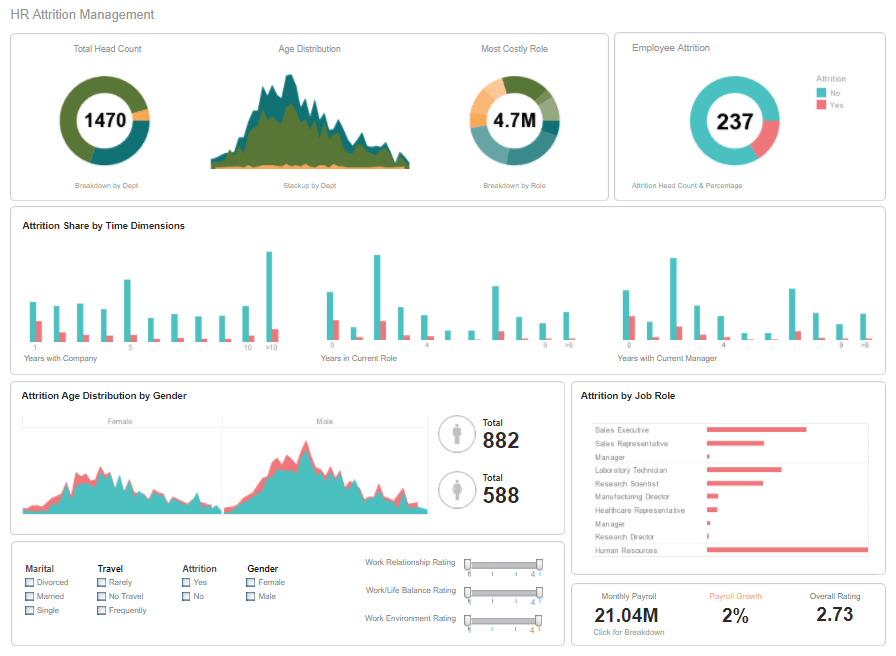Tracking Human Resources Key Performance Indicators
InetSoft's business intelligence software can be used to track any HR Key Performance Indicator (KPI). For example, you may need to chart average number of training hours per employee, staff turnover, average training costs per employee, and HR FTE to total FTE ratio.
InetSoft offers KPI tracking software that is...
Easy enough to be:
- Deployed in just weeks
- Learned by end users with minor training
- Utilized by any executive without the aid of IT
- Adapt to however you define your HR KPIs
- Allow exploration for performance trends via visualization techniques
- Enable maximum self service
- Satisfying executive demands
- Meeting the requirements of power users
- Scaling up for organizations of any size
StyleBI from InetSoft, It's Easy, Agile & Robust
Key Performance Indicators Used in HR: What They Mean and How to Use Them
Key Performance Indicators (KPIs) are essential tools for Human Resources departments to measure, monitor, and optimize HR processes that directly impact organizational performance. By understanding and using HR KPIs effectively, HR professionals can align talent management with business goals, improve employee satisfaction, reduce turnover, and enhance operational efficiency.
1️⃣ Employee Turnover Rate
The Employee Turnover Rate measures the percentage of employees who leave the organization over a specific period, typically calculated monthly, quarterly, or annually.
Formula: (Number of separations during the period / Average number of employees during the period) x 100
A high turnover rate may indicate dissatisfaction, poor workplace culture, or ineffective hiring practices. Monitoring this KPI helps HR teams identify trends and implement retention strategies, such as career development programs, engagement initiatives, and competitive compensation plans.
2️⃣ Time to Fill
Time to Fill measures the average number of days it takes to fill an open position from the moment the job requisition is approved until the candidate accepts the offer.
This KPI reflects the efficiency of the recruitment process. A high Time to Fill may indicate inefficiencies in sourcing, interviewing, or decision-making, which can negatively impact productivity. HR teams should track this metric to streamline recruitment workflows, improve candidate pipelines, and benchmark hiring timelines against industry standards.
3️⃣ Time to Hire
Time to Hire is similar to Time to Fill but measures the time between a candidate applying (or being sourced) and accepting the job offer.
This KPI is critical for understanding the candidate experience and recruitment team responsiveness. By analyzing Time to Hire, HR can identify delays in the interview and assessment stages, optimize communication with candidates, and reduce the risk of losing top talent to competitors.
4️⃣ Absenteeism Rate
Absenteeism Rate measures the percentage of workdays lost due to unscheduled employee absences.
Formula: (Total number of absent days / Total number of available workdays) x 100
High absenteeism may indicate low employee engagement, workplace stress, or health and safety issues. HR can use this KPI to monitor patterns and develop wellness programs, flexible work arrangements, or attendance policies to improve workforce reliability.
5️⃣ Employee Engagement Score
Employee Engagement Score is typically derived from survey responses measuring employee satisfaction, commitment, and enthusiasm for their work and the organization.
Engaged employees are more productive, innovative, and less likely to leave. By monitoring this KPI, HR can identify departments or teams with low engagement and design targeted interventions, such as leadership development, recognition programs, and feedback mechanisms, to improve morale.
6️⃣ Cost Per Hire
Cost Per Hire measures the total cost associated with hiring a new employee, including advertising, recruiter fees, onboarding, and administrative costs.
Formula: Total recruitment costs / Number of hires
Tracking this KPI helps HR manage recruitment budgets effectively while balancing cost-efficiency with the need to attract high-quality candidates. A rising Cost Per Hire may indicate the need to review sourcing strategies, enhance employer branding, or improve internal referrals.
7️⃣ Training Effectiveness
Training Effectiveness measures how well training programs improve employee skills and contribute to organizational objectives.
Metrics used to assess training effectiveness may include post-training assessments, improvements in employee performance, and feedback surveys. HR teams should track this KPI to ensure learning investments are aligned with skill gaps, reduce onboarding time, and increase productivity.
8️⃣ Offer Acceptance Rate
Offer Acceptance Rate measures the percentage of job offers accepted by candidates compared to the total offers extended.
Formula: (Number of accepted offers / Number of offers extended) x 100
A low acceptance rate may indicate issues with compensation, slow hiring processes, or a poor candidate experience. Monitoring this KPI enables HR to refine offer strategies, improve employer branding, and remain competitive in the talent market.
9️⃣ Diversity Ratio
The Diversity Ratio measures the proportion of employees from underrepresented groups within the organization.
Monitoring diversity KPIs helps HR track progress toward diversity, equity, and inclusion (DEI) goals. HR teams can use this KPI to develop targeted recruitment strategies, assess pay equity, and ensure a diverse talent pipeline for leadership roles.
10️⃣ Internal Promotion Rate
Internal Promotion Rate measures the percentage of open positions filled by internal candidates.
Formula: (Number of internal promotions / Total number of open positions) x 100
This KPI indicates the effectiveness of internal mobility programs and succession planning. A high internal promotion rate demonstrates career growth opportunities within the organization, which supports employee retention and reduces hiring costs.
Using HR KPIs Effectively
To effectively use HR KPIs:
- Align KPIs with Business Goals: HR KPIs should support organizational objectives such as growth, productivity, and employee well-being.
- Use Dashboards for Visibility: Tools like InetSoft’s StyleBI can automate HR KPI tracking and visualize metrics using charts, graphs, and heatmaps for actionable insights.
- Benchmark and Analyze Trends: Compare your KPIs to industry benchmarks to identify improvement opportunities and track progress over time.
- Involve Stakeholders: Share KPI reports with managers to align team goals with HR strategies and encourage data-driven decision-making.
- Act on Insights: Use KPI findings to refine policies, improve recruitment, enhance employee experiences, and drive cultural initiatives.
